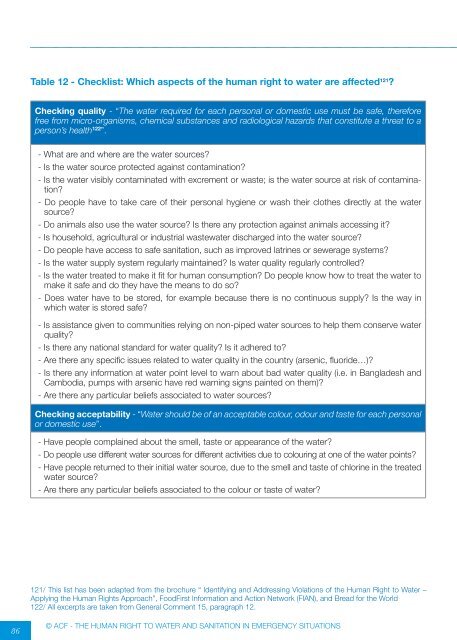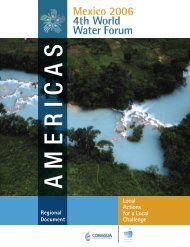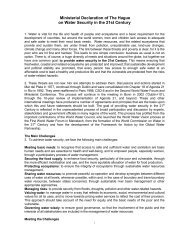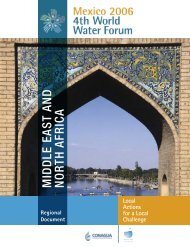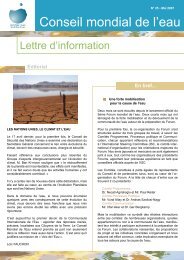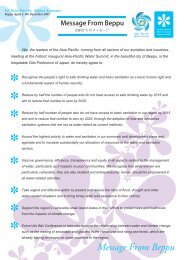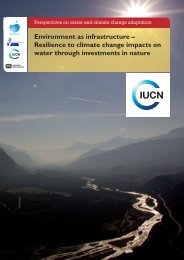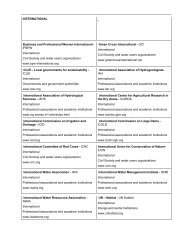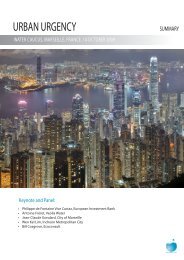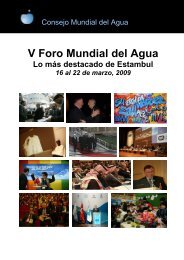the human right to water and sanitation in emergency situations
the human right to water and sanitation in emergency situations
the human right to water and sanitation in emergency situations
You also want an ePaper? Increase the reach of your titles
YUMPU automatically turns print PDFs into web optimized ePapers that Google loves.
86<br />
Table 12 - Checklist: Which aspects of <strong>the</strong> <strong>human</strong> <strong>right</strong> <strong>to</strong> <strong>water</strong> are affected 121 ?<br />
Check<strong>in</strong>g quality - “The <strong>water</strong> required for each personal or domestic use must be safe, <strong>the</strong>refore<br />
free from micro-organisms, chemical substances <strong>and</strong> radiological hazards that constitute a threat <strong>to</strong> a<br />
person’s health 122 ”.<br />
- What are <strong>and</strong> where are <strong>the</strong> <strong>water</strong> sources?<br />
- Is <strong>the</strong> <strong>water</strong> source protected aga<strong>in</strong>st contam<strong>in</strong>ation?<br />
- Is <strong>the</strong> <strong>water</strong> visibly contam<strong>in</strong>ated with excrement or waste; is <strong>the</strong> <strong>water</strong> source at risk of contam<strong>in</strong>ation?<br />
- Do people have <strong>to</strong> take care of <strong>the</strong>ir personal hygiene or wash <strong>the</strong>ir clo<strong>the</strong>s directly at <strong>the</strong> <strong>water</strong><br />
source?<br />
- Do animals also use <strong>the</strong> <strong>water</strong> source? Is <strong>the</strong>re any protection aga<strong>in</strong>st animals access<strong>in</strong>g it?<br />
- Is household, agricultural or <strong>in</strong>dustrial waste<strong>water</strong> discharged <strong>in</strong><strong>to</strong> <strong>the</strong> <strong>water</strong> source?<br />
- Do people have access <strong>to</strong> safe <strong>sanitation</strong>, such as improved latr<strong>in</strong>es or sewerage systems?<br />
- Is <strong>the</strong> <strong>water</strong> supply system regularly ma<strong>in</strong>ta<strong>in</strong>ed? Is <strong>water</strong> quality regularly controlled?<br />
- Is <strong>the</strong> <strong>water</strong> treated <strong>to</strong> make it fit for <strong>human</strong> consumption? Do people know how <strong>to</strong> treat <strong>the</strong> <strong>water</strong> <strong>to</strong><br />
make it safe <strong>and</strong> do <strong>the</strong>y have <strong>the</strong> means <strong>to</strong> do so?<br />
- Does <strong>water</strong> have <strong>to</strong> be s<strong>to</strong>red, for example because <strong>the</strong>re is no cont<strong>in</strong>uous supply? Is <strong>the</strong> way <strong>in</strong><br />
which <strong>water</strong> is s<strong>to</strong>red safe?<br />
- Is assistance given <strong>to</strong> communities rely<strong>in</strong>g on non-piped <strong>water</strong> sources <strong>to</strong> help <strong>the</strong>m conserve <strong>water</strong><br />
quality?<br />
- Is <strong>the</strong>re any national st<strong>and</strong>ard for <strong>water</strong> quality? Is it adhered <strong>to</strong>?<br />
- Are <strong>the</strong>re any specific issues related <strong>to</strong> <strong>water</strong> quality <strong>in</strong> <strong>the</strong> country (arsenic, fluoride…)?<br />
- Is <strong>the</strong>re any <strong>in</strong>formation at <strong>water</strong> po<strong>in</strong>t level <strong>to</strong> warn about bad <strong>water</strong> quality (i.e. <strong>in</strong> Bangladesh <strong>and</strong><br />
Cambodia, pumps with arsenic have red warn<strong>in</strong>g signs pa<strong>in</strong>ted on <strong>the</strong>m)?<br />
- Are <strong>the</strong>re any particular beliefs associated <strong>to</strong> <strong>water</strong> sources?<br />
Check<strong>in</strong>g acceptability - “Water should be of an acceptable colour, odour <strong>and</strong> taste for each personal<br />
or domestic use”.<br />
- Have people compla<strong>in</strong>ed about <strong>the</strong> smell, taste or appearance of <strong>the</strong> <strong>water</strong>?<br />
- Do people use different <strong>water</strong> sources for different activities due <strong>to</strong> colour<strong>in</strong>g at one of <strong>the</strong> <strong>water</strong> po<strong>in</strong>ts?<br />
- Have people returned <strong>to</strong> <strong>the</strong>ir <strong>in</strong>itial <strong>water</strong> source, due <strong>to</strong> <strong>the</strong> smell <strong>and</strong> taste of chlor<strong>in</strong>e <strong>in</strong> <strong>the</strong> treated<br />
<strong>water</strong> source?<br />
- Are <strong>the</strong>re any particular beliefs associated <strong>to</strong> <strong>the</strong> colour or taste of <strong>water</strong>?<br />
121/ This list has been adapted from <strong>the</strong> brochure “ Identify<strong>in</strong>g <strong>and</strong> Address<strong>in</strong>g Violations of <strong>the</strong> Human Right <strong>to</strong> Water –<br />
Apply<strong>in</strong>g <strong>the</strong> Human Rights Approach”, FoodFirst Information <strong>and</strong> Action Network (FIAN), <strong>and</strong> Bread for <strong>the</strong> World<br />
122/ All excerpts are taken from General Comment 15, paragraph 12.<br />
© ACF - THE HUMAN RIGHT TO WATER AND SANITATION IN EMERGENCY SITUATIONS


